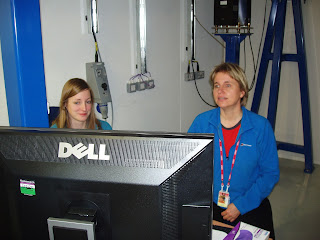Plan C sort of worked and Plan D didn't.
Plan C was to try the cryomicrotoming again. The granules still crumbled as we sliced them but we did get a rim of granule material around a hole.
 |
| Here you can see the outlines of two granules left on a cryomicrotomed section. Granule material is just left around the rims. We took this image using the FTIR microscope (in visible light) and then told the machine to collect FTIR spectra around the rims. Field of view is about 3 mm. |
We are producing maps from these sections (actually a whole host of individual point analyses) to see what we shall see. We need to process the spectra to remove any signal from the glue used in the cryomicrotoming (a pva adhesive) and then look at the ratio of a few peaks to determine the amorphous calcium carbonate content in each spectrum.
 |
| A FTIR spectrum of calcite taken off line (i.e. we've done this on a normal machine as a reference material) with an ATR (attenuated reflectance) set up. The 3 big peaks on the right (at about 1400, 870 and 710 cm-1) are characteristic of crystalline calcium carbonate. If the 710 cm-1 peak is missing it's amorphous calcium carbonate. |
Plan D was to simply squash a granule on to a slide but it didn't work. You can do IR in a number of ways. For the thin slices produced by microtoming we look at the light going through the sample - a transmission measurement - and that seems to work for our slices. For the crushed granule the sample is to thick for transmission so we look at the IR light reflected from the surface - a reflectance measurement. However, the crushed samples didn't give good spectra in reflectance - they may not have been smooth enough.
When we return in February we're still going to try the slices produced using "normal" methods - embed the granule in resin, polish it down with a Diamond polishing nap to get a thin section. However we will try (another) FTIR measurement technique - ATR (attenuated reflection). In this technique we actually have contact between a diamond lens and the sample. This is how "classical" FTIR works and should be fine giving spectra like the one above.
Meanwhile we were visited on the beamline by Brian Clegg, a science writer, who is doing an article for the Observer. The article will be about Diamond and the science we do here and should appear in January.
Brian Clegg (science writer) and Sarah Bucknall from the Diamond Communications team.





